2018 TOYOTA AVENSIS ECO mode
[x] Cancel search: ECO modePage 476 of 660
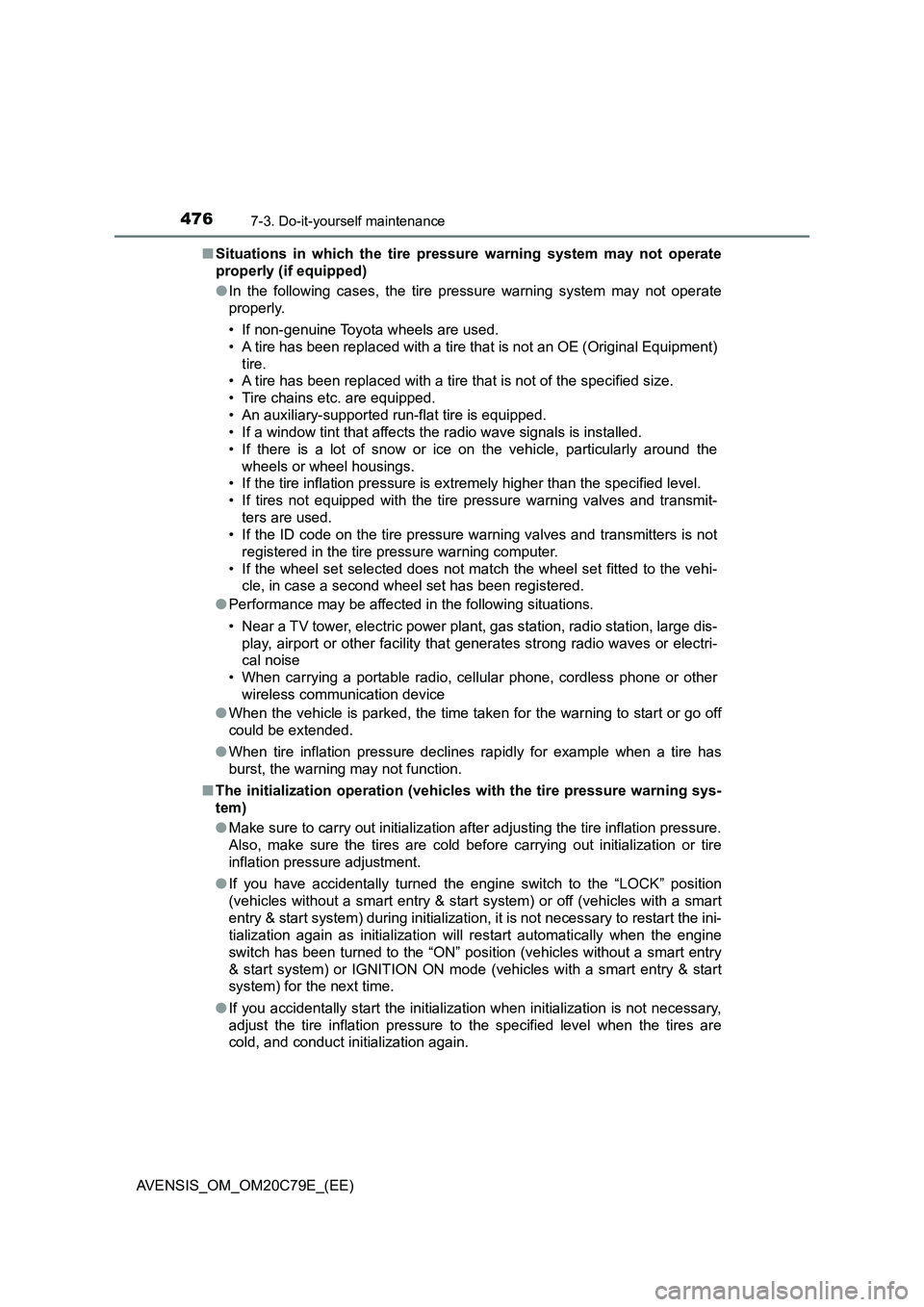
4767-3. Do-it-yourself maintenance
AVENSIS_OM_OM20C79E_(EE)■Situations in which the tire pressure warning system may not operate
properly (if equipped)
●In the following cases, the tire pressure warning system may not operate
properly.
• If non-genuine Toyota wheels are used.
• A tire has been replaced with a tire that is not an OE (Original Equipment)
tire.
• A tire has been replaced with a tire that is not of the specified size.
• Tire chains etc. are equipped.
• An auxiliary-supported run-flat tire is equipped.
• If a window tint that affects the radio wave signals is installed.
• If there is a lot of snow or ice on the vehicle, particularly around the
wheels or wheel housings.
• If the tire inflation pressure is extremely higher than the specified level.
• If tires not equipped with the tire pressure warning valves and transmit-
ters are used.
• If the ID code on the tire pressure warning valves and transmitters is not
registered in the tire pressure warning computer.
• If the wheel set selected does not match the wheel set fitted to the vehi-
cle, in case a second wheel set has been registered.
●Performance may be affected in the following situations.
• Near a TV tower, electric power plant, gas station, radio station, large dis-
play, airport or other facility that generates strong radio waves or electri-
cal noise
• When carrying a portable radio, cellular phone, cordless phone or other
wireless communication device
●When the vehicle is parked, the time taken for the warning to start or go off
could be extended.
●When tire inflation pressure declines rapidly for example when a tire has
burst, the warning may not function.
■The initialization operation (vehicles with the tire pressure warning sys-
tem)
●Make sure to carry out initialization after adjusting the tire inflation pressure.
Also, make sure the tires are cold before carrying out initialization or tire
inflation pressure adjustment.
●If you have accidentally turned the engine switch to the “LOCK” position
(vehicles without a smart entry & start system) or off (vehicles with a smart
entry & start system) during initialization, it is not necessary to restart the ini-
tialization again as initialization will restart automatically when the engine
switch has been turned to the “ON” position (vehicles without a smart entry
& start system) or IGNITION ON mode (vehicles with a smart entry & start
system) for the next time.
●If you accidentally start the initialization when initialization is not necessary,
adjust the tire inflation pressure to the specified level when the tires are
cold, and conduct initialization again.
Page 484 of 660
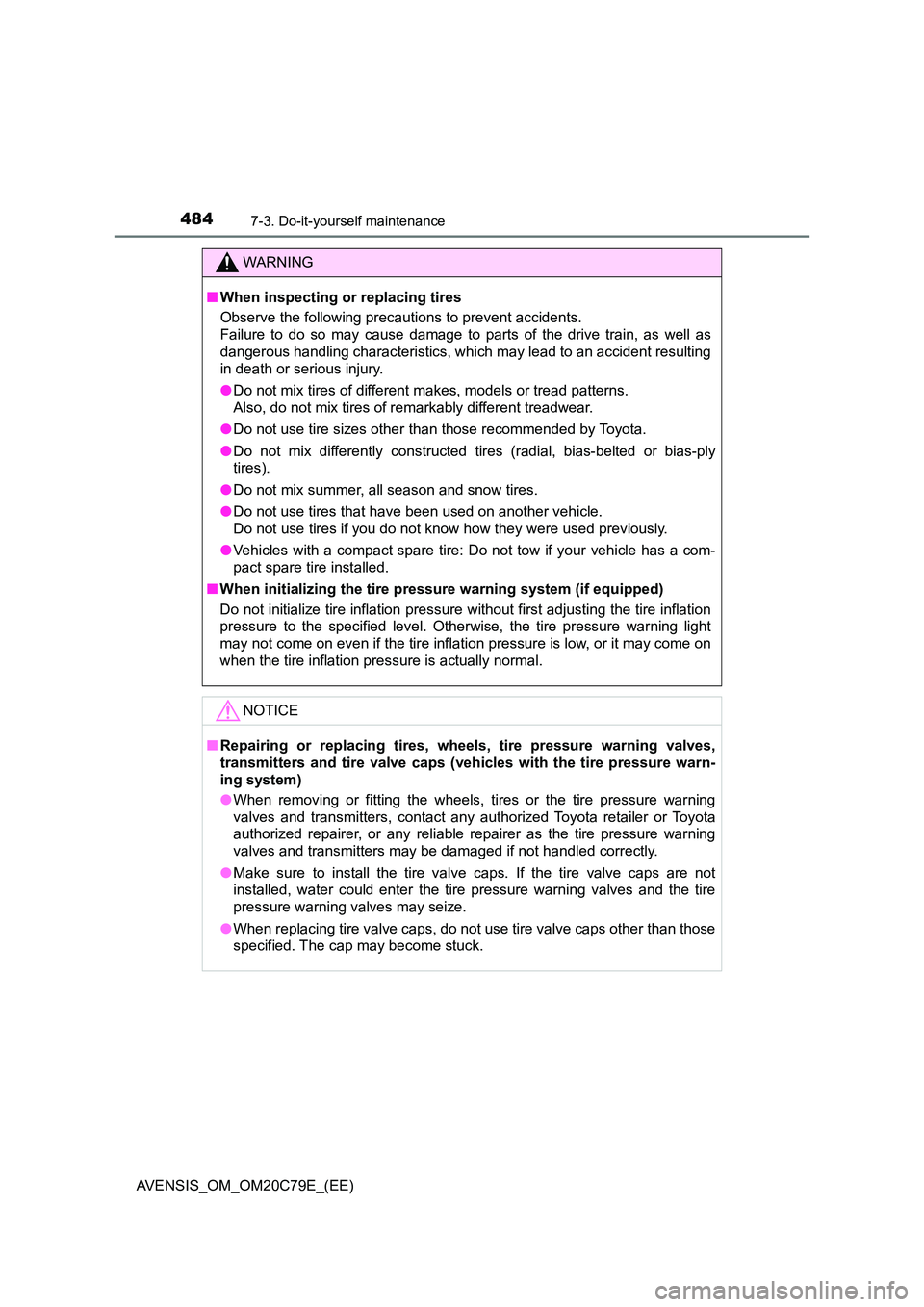
4847-3. Do-it-yourself maintenance
AVENSIS_OM_OM20C79E_(EE)
WARNING
■When inspecting or replacing tires
Observe the following precautions to prevent accidents.
Failure to do so may cause damage to par ts of the drive train, as well as
dangerous handling characteristics, which may lead to an accident resulting
in death or serious injury.
● Do not mix tires of different makes, models or tread patterns.
Also, do not mix tires of remarkably different treadwear.
● Do not use tire sizes other than those recommended by Toyota.
● Do not mix differently constructed tires (radial, bias-belted or bias-ply
tires).
● Do not mix summer, all season and snow tires.
● Do not use tires that have been used on another vehicle.
Do not use tires if you do not know how they were used previously.
● Vehicles with a compact spare tire: Do not tow if your vehicle has a com-
pact spare tire installed.
■ When initializing the tire pressure warning system (if equipped)
Do not initialize tire inflation pressure without first adjusting the tire inflation
pressure to the specified level. Otherwise, the tire pressure warning light
may not come on even if the tire inflation pressure is low, or it may come on
when the tire inflation pressure is actually normal.
NOTICE
■ Repairing or replacing tires, wheels, tire pressure warning valves,
transmitters and tire valve caps (vehicles with the tire pressure warn-
ing system)
● When removing or fitting the wheels, tires or the tire pressure warning
valves and transmitters, contact any authorized Toyota retailer or Toyota
authorized repairer, or any reliable repairer as the tire pressure warning
valves and transmitters may be damaged if not handled correctly.
● Make sure to install the tire valve caps. If the tire valve caps are not
installed, water could enter the tire pressure warning valves and the tire
pressure warning valves may seize.
● When replacing tire valve caps, do not use tire valve caps other than those
specified. The cap may become stuck.
Page 535 of 660
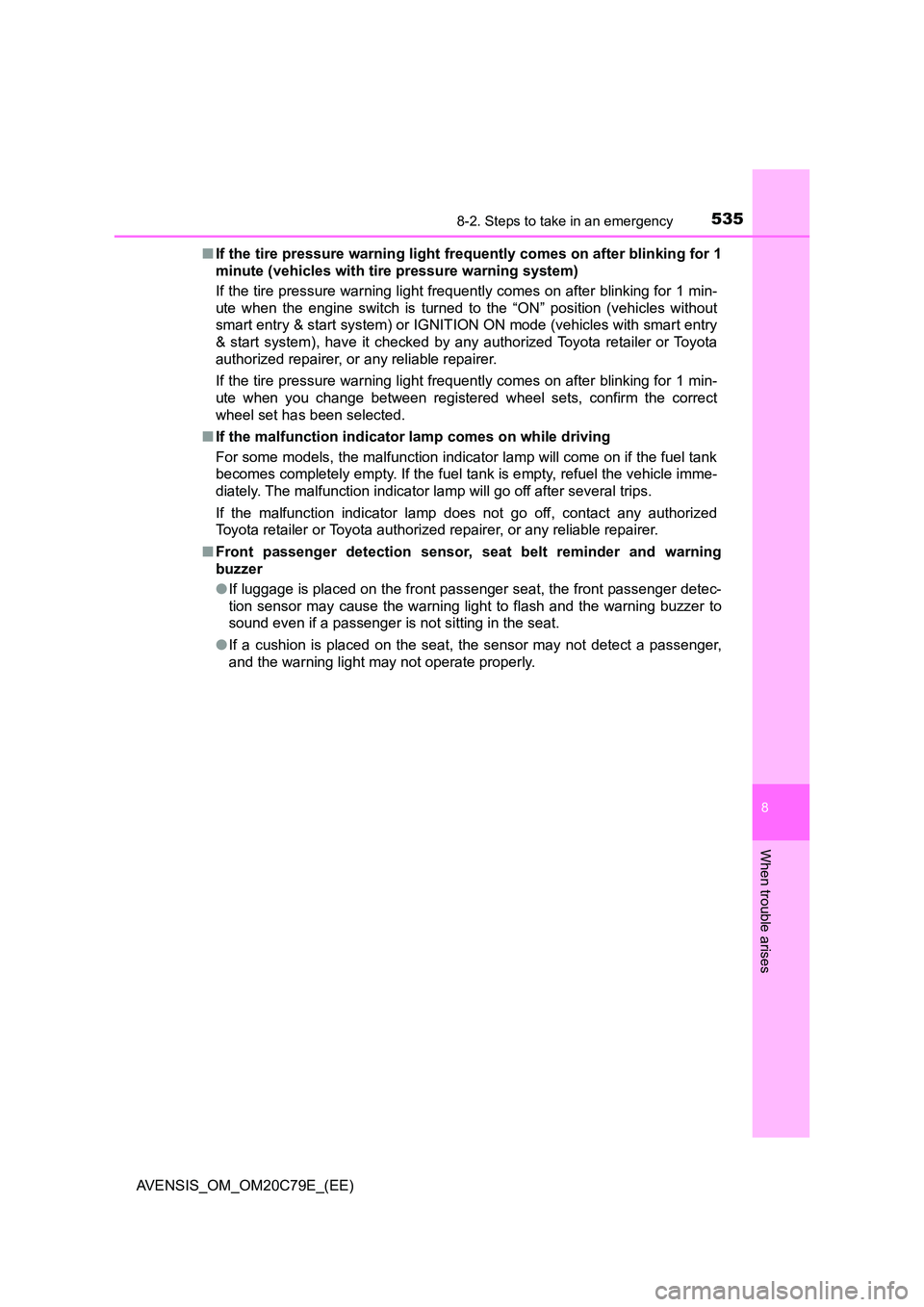
5358-2. Steps to take in an emergency
AVENSIS_OM_OM20C79E_(EE)
8
When trouble arises
■If the tire pressure warning light frequently comes on after blinking for 1
minute (vehicles with tire pressure warning system)
If the tire pressure warning light frequently comes on after blinking for 1 min-
ute when the engine switch is turned to the “ON” position (vehicles without
smart entry & start system) or IGNITION ON mode (vehicles with smart entry
& start system), have it checked by any authorized Toyota retailer or Toyota
authorized repairer, or any reliable repairer.
If the tire pressure warning light frequently comes on after blinking for 1 min-
ute when you change between registered wheel sets, confirm the correct
wheel set has been selected.
■ If the malfunction indicator lamp comes on while driving
For some models, the malfunction indicator lamp will come on if the fuel tank
becomes completely empty. If the fuel tank is empty, refuel the vehicle imme-
diately. The malfunction indicator lamp will go off after several trips.
If the malfunction indicator lamp does not go off, contact any authorized
Toyota retailer or Toyota authorized repairer, or any reliable repairer.
■ Front passenger detection sensor, seat belt reminder and warning
buzzer
● If luggage is placed on the front passenger seat, the front passenger detec-
tion sensor may cause the warning light to flash and the warning buzzer to
sound even if a passenger is not sitting in the seat.
● If a cushion is placed on the seat, the sensor may not detect a passenger,
and the warning light may not operate properly.
Page 540 of 660
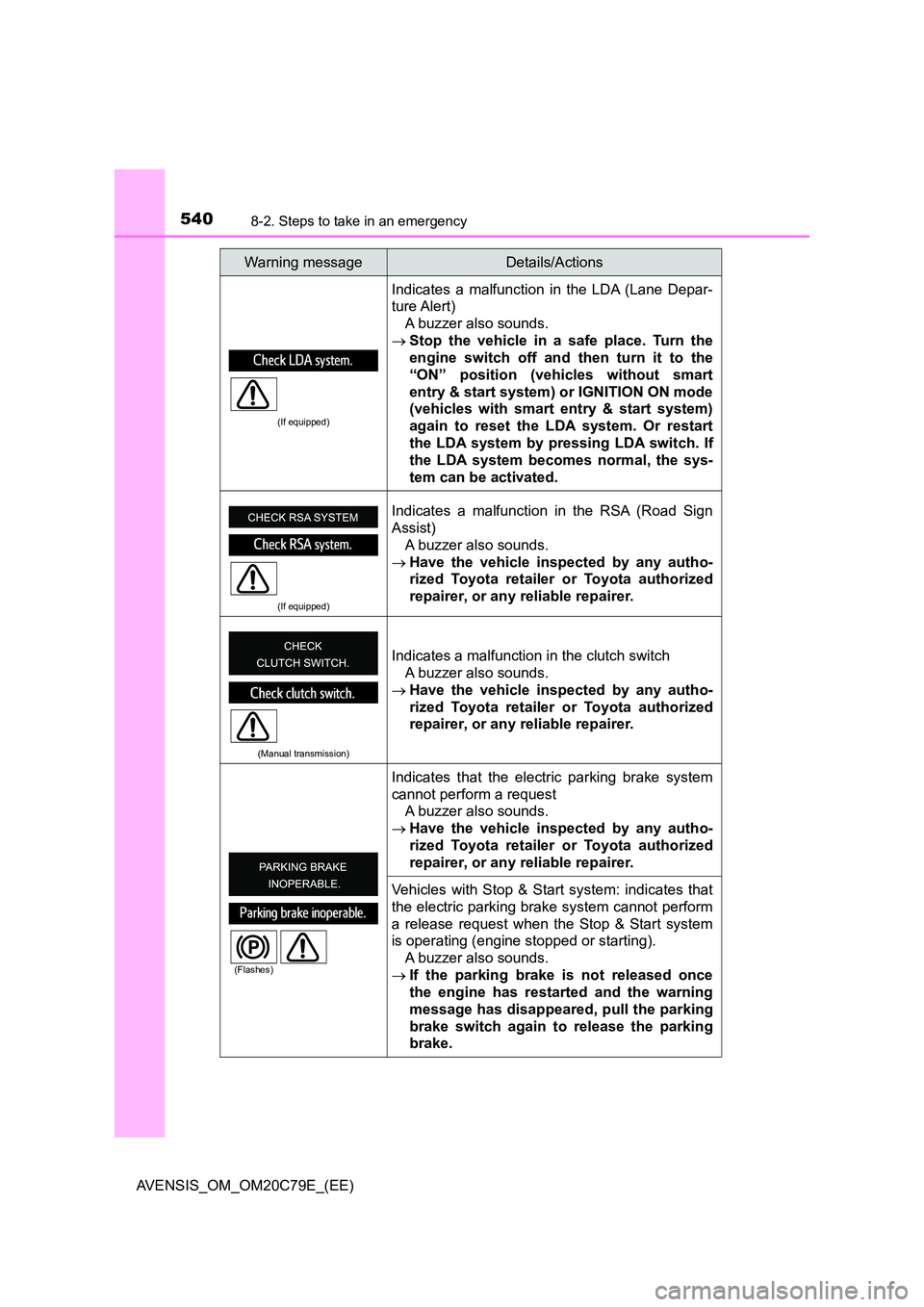
5408-2. Steps to take in an emergency
AVENSIS_OM_OM20C79E_(EE)
(If equipped)
Indicates a malfunction in the LDA (Lane Depar-
ture Alert)
A buzzer also sounds.
Stop the vehicle in a safe place. Turn the
engine switch off and then turn it to the
“ON” position (vehicles without smart
entry & start system) or IGNITION ON mode
(vehicles with smart entry & start system)
again to reset the LDA system. Or restart
the LDA system by pressing LDA switch. If
the LDA system becomes normal, the sys-
tem can be activated.
(If equipped)
Indicates a malfunction in the RSA (Road Sign
Assist)
A buzzer also sounds.
Have the vehicle inspected by any autho-
rized Toyota retailer or Toyota authorized
repairer, or any reliable repairer.
(Manual transmission)
Indicates a malfunction in the clutch switch
A buzzer also sounds.
Have the vehicle inspected by any autho-
rized Toyota retailer or Toyota authorized
repairer, or any reliable repairer.
Indicates that the electric parking brake system
cannot perform a request
A buzzer also sounds.
Have the vehicle inspected by any autho-
rized Toyota retailer or Toyota authorized
repairer, or any reliable repairer.
Vehicles with Stop & Start system: indicates that
the electric parking brake system cannot perform
a release request when the Stop & Start system
is operating (engine stopped or starting).
A buzzer also sounds.
If the parking brake is not released once
the engine has restarted and the warning
message has disappeared, pull the parking
brake switch again to release the parking
brake.
Warning messageDetails/Actions
(Flashes)
Page 548 of 660
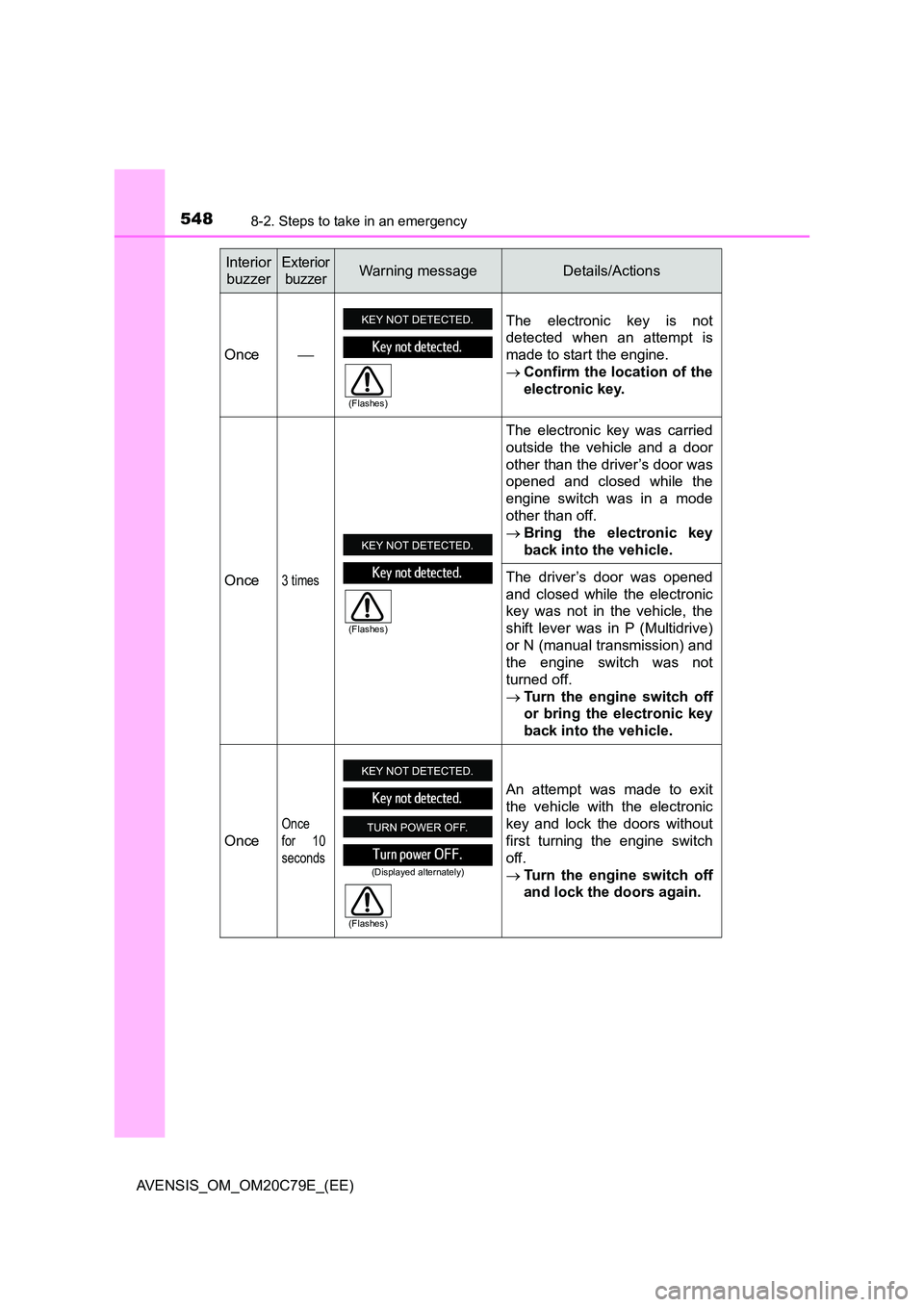
5488-2. Steps to take in an emergency
AVENSIS_OM_OM20C79E_(EE)
Interior
buzzer
Exterior
buzzerWarning messageDetails/Actions
Once
The electronic key is not
detected when an attempt is
made to start the engine.
Confirm the location of the
electronic key.
Once3 times
The electronic key was carried
outside the vehicle and a door
other than the driver’s door was
opened and closed while the
engine switch was in a mode
other than off.
Bring the electronic key
back into the vehicle.
The driver’s door was opened
and closed while the electronic
key was not in the vehicle, the
shift lever was in P (Multidrive)
or N (manual transmission) and
the engine switch was not
turned off.
Turn the engine switch off
or bring the electronic key
back into the vehicle.
Once
Once
for 10
seconds
An attempt was made to exit
the vehicle with the electronic
key and lock the doors without
first turning the engine switch
off.
Turn the engine switch off
and lock the doors again.
(Flashes)
(Flashes)
(Displayed alternately)
(Flashes)
Page 553 of 660
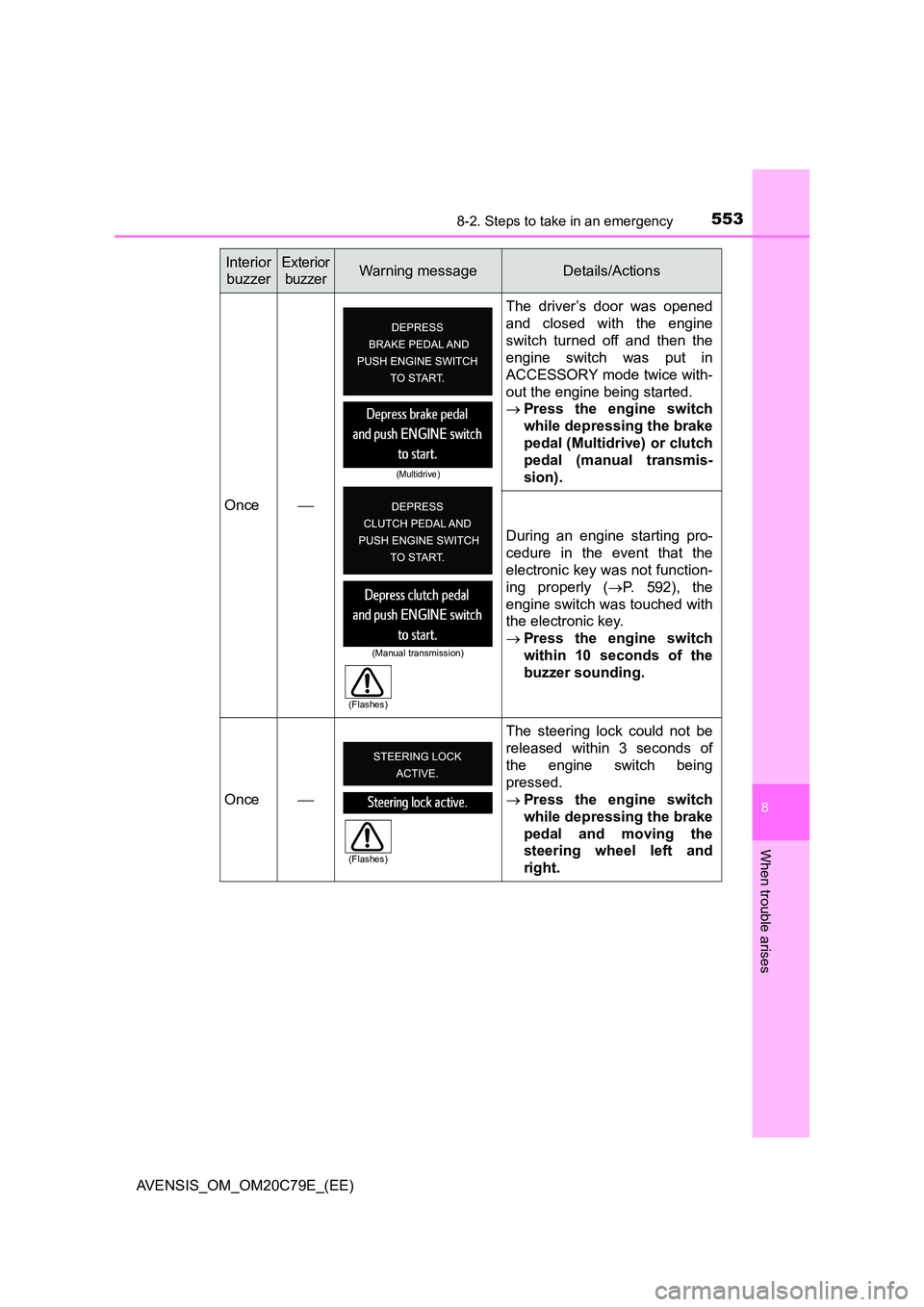
5538-2. Steps to take in an emergency
AVENSIS_OM_OM20C79E_(EE)
8
When trouble arises
Once
The driver’s door was opened
and closed with the engine
switch turned off and then the
engine switch was put in
ACCESSORY mode twice with-
out the engine being started.
Press the engine switch
while depressing the brake
pedal (Multidrive) or clutch
pedal (manual transmis-
sion).
During an engine starting pro-
cedure in the event that the
electronic key was not function-
ing properly ( P. 592), the
engine switch was touched with
the electronic key.
Press the engine switch
within 10 seconds of the
buzzer sounding.
Once
The steering lock could not be
released within 3 seconds of
the engine switch being
pressed.
Press the engine switch
while depressing the brake
pedal and moving the
steering wheel left and
right.
Interior
buzzer
Exterior
buzzerWarning messageDetails/Actions
(Multidrive)
(Manual transmission)
(Flashes)
(Flashes)
Page 587 of 660
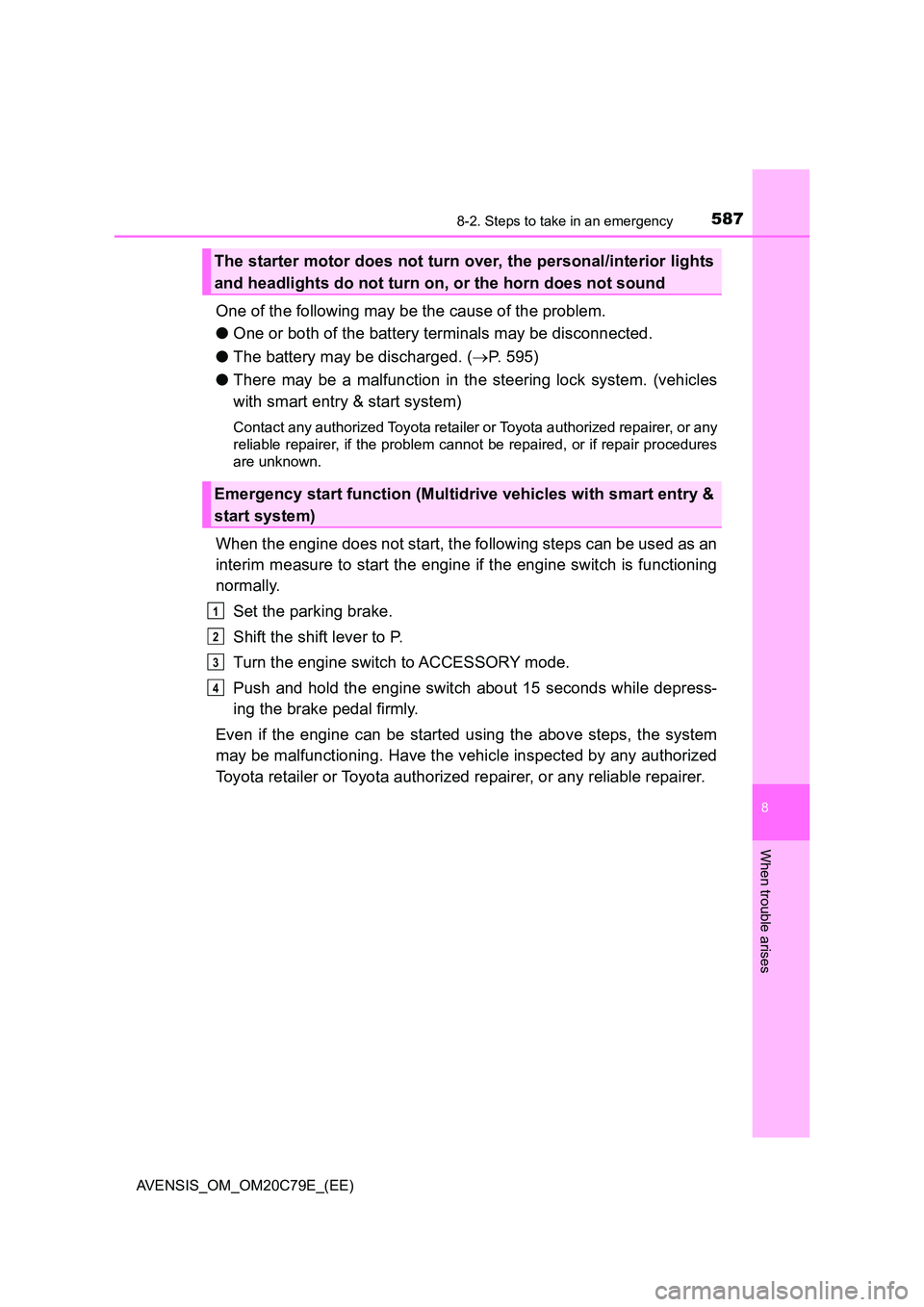
5878-2. Steps to take in an emergency
AVENSIS_OM_OM20C79E_(EE)
8
When trouble arises
One of the following may be the cause of the problem.
● One or both of the battery terminals may be disconnected.
● The battery may be discharged. (P. 595)
● There may be a malfunction in the steering lock system. (vehicles
with smart entry & start system)
Contact any authorized Toyota retailer or Toyota authorized repairer, or any
reliable repairer, if the problem cannot be repaired, or if repair procedures
are unknown.
When the engine does not start, the following steps can be used as an
interim measure to start the engine if the engine switch is functioning
normally.
Set the parking brake.
Shift the shift lever to P.
Turn the engine switch to ACCESSORY mode.
Push and hold the engine switch about 15 seconds while depress-
ing the brake pedal firmly.
Even if the engine can be started using the above steps, the system
may be malfunctioning. Have the vehicle inspected by any authorized
Toyota retailer or Toyota authorized repairer, or any reliable repairer.
The starter motor does not turn over, the personal/interior lights
and headlights do not turn on, or the horn does not sound
Emergency start function (Multidrive vehicles with smart entry &
start system)
1
2
3
4
Page 594 of 660
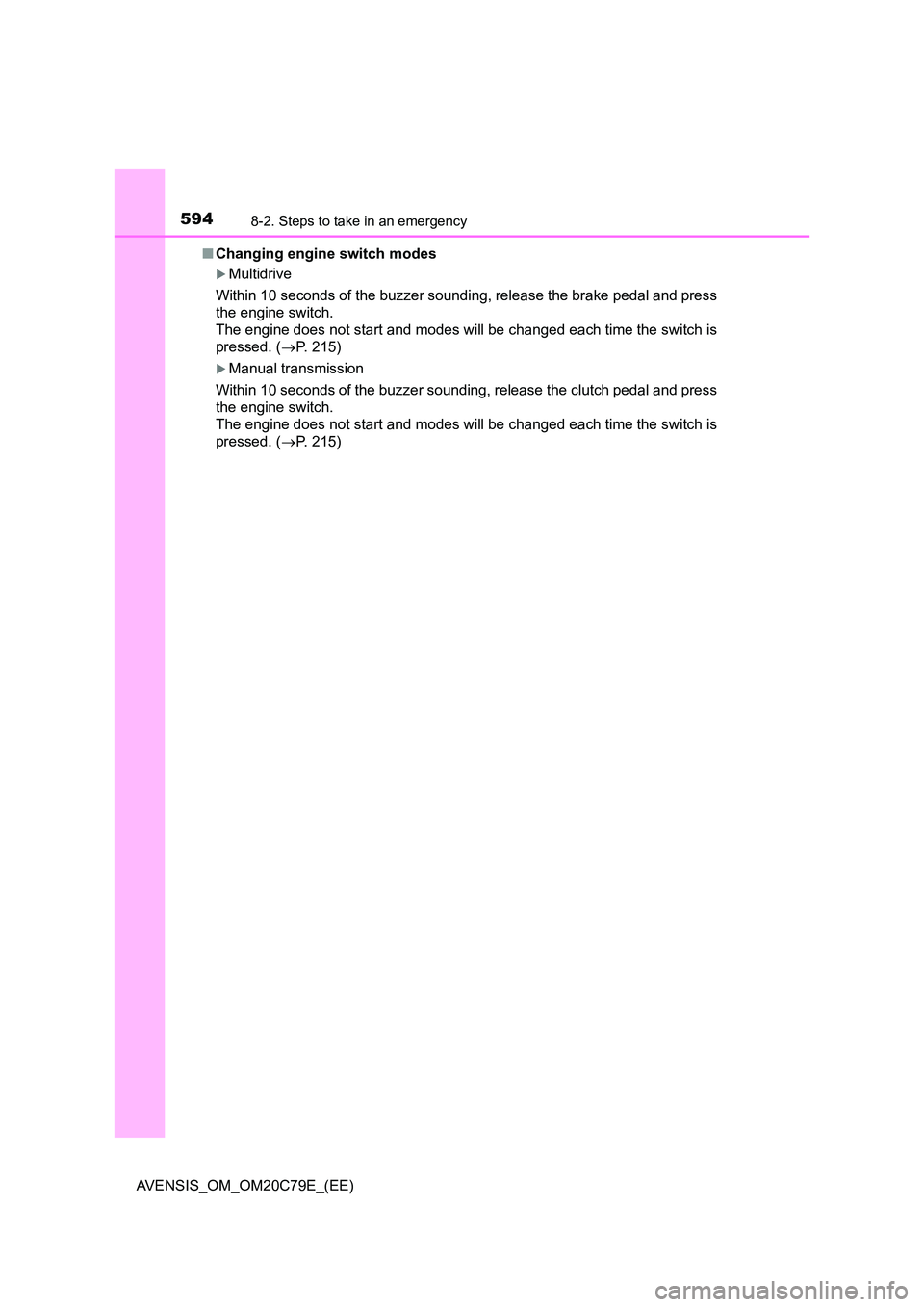
5948-2. Steps to take in an emergency
AVENSIS_OM_OM20C79E_(EE)
■ Changing engine switch modes
Multidrive
Within 10 seconds of the buzzer sounding, release the brake pedal and press
the engine switch.
The engine does not start and modes will be changed each time the switch is
pressed. ( P. 215)
Manual transmission
Within 10 seconds of the buzzer sounding, release the clutch pedal and press
the engine switch.
The engine does not start and modes will be changed each time the switch is
pressed. ( P. 215)